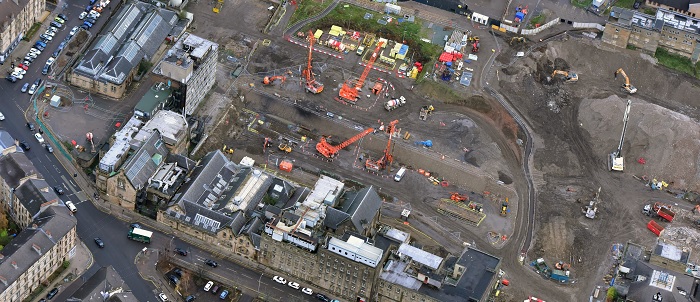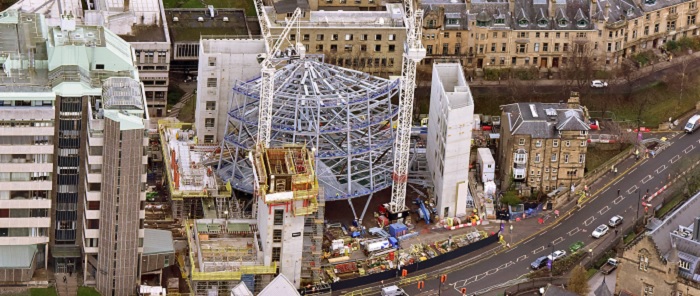Campus development - your questions answered
Published: 11 April 2019
Ann Allen, Executive Director of Estates & Commercial Services responds to staff and students
Campus development questions & answers
1. There doesn't seem to be a car park - is that correct? If not, why not? I normally use public transport but it's not an option for everyone.
The masterplan for the Western site was developed after extensive consultation and reflects several key design principles that were embedded in our strategic approach through the Development Framework. A key design principle was that pedestrians would have priority over vehicles within the boundaries of the campus. Large parts of the site will not have vehicle access other than for emergency purposes. A Strategic Travel and Transport Plan (STTP) has been established to support the development: it is aimed at supporting more travel choice to those travelling to the University. The University is investing in measures to encourage active travel (walking and cycling), improve access to public transport and manage the University’s parking supply more effective.
2. Are you going to demolish the McGregor Building? I really hope so, and soon. I appreciate that some small parts of it are attractive & worth preserving, but most of it is an eyesore.
The front part of the McGregor Building is listed and under the terms of the approval of the masterplan, we need to retain the historic portion of the building. In the shorter term this will be conserved and then developed in future phases of development into part of the University’s commercial and innovation zone. The more modern extensions to the east, however, are in the process of being demolished. This will then allow us to start the construction of the new Clarice Pears building which will provide accommodation for the Institute of Health and Wellbeing.

3. What is going to happen to the WIG Chapel?
The Western Infirmary Chapel is to be retained and will be an important edge to the new piazza that is being developed linking Church Street with the Research Hub. We are still considering the best use for the Chapel but we are making sure that the building itself is protected during the construction work.
4. Are you going to increase the parking spaces on campus or build a multi-storey carpark on or near the University (maybe on South Street) so that people can get to work? I understand that the new Hub will not have any underground parking so we are losing spaces on the old Boyd Orr car park. We badly need more parking as cycling to work is not an option and the Council is making more of the streets around the University paid parking zones. Some of the lecturers in my building who had parking permits for years were not able to get one this year and it is making life more difficult for them. The west end badly needs multi-storey car parks.
We are not increasing the number of car parking spaces currently provided on the campus. A new parking scheme was introduced a number of months ago after extensive discussion and consideration. Whilst as a result of the new application process some people did not get their permits renewed, the new system has allowed people who have joined the University in more recent years to have the opportunity to apply. The new system is based onan annual permit scheme with a clear set of criteria and should make allocation of parking permits fairer.
5. I would like to ask why there was a decision made not to seriously improve cycle safety on University Avenue. I understand you are increasing the width of the cycle lane, but why when you are spending all this money are you not installing raised kerbs to separate cars from the cycle lane? It is essential that we encourage more people to actively travel to their place of study or work and it is well known that the lack of safe cycling infrastructure puts people off cycling in the City of Glasgow.
I find it very disappointing that Glasgow University have not invested in this for their students, staff and local community, especially when we know active travel is a key way to increase people’s activity levels and support their mental and physical wellbeing. We should be leading the way with this type of project and showing staff and students that we care about their health by improving active travel infrastructure. Please note, this is a separate issue to widening pavements and is specifically about cycling.
The changes being made to University Avenue do accommodate needs of all users within the national transport hierarchy and the design meets relevant technical road safety requirements. They also ensure the Avenue remains two-way for traffic, which was the preference from options discussed with Glasgow City Council.
It is a fact that the vast majority of users of University Avenue are pedestrians therefore widening of the footpaths was always our primary objective. Working under these parameters, unfortunately it proved impossible to accommodate segregated cycling, along with wider footpaths and two-way vehicle access, due to space pressures.
It is perhaps worth noting that our plans for the new Western campus will provide new cycle-friendly routes with Kelvingrove Park linking directly to the off-road National Cycle Network. The new infrastructure being delivered by the University will also allow connections to emerging City Deal initiatives, including Byres Road, ensuring vehicle-restricted routes are available from the campus and the wider cycle network.
We are investing in enhancing our active travel provisions. The removal of on-street parking, reduction in speed limit and introduction of measures to reduce bus and taxis stopping in cycle lanes will make the Avenue safer for cyclists.
6. The recent withdrawal of parking permits from hundreds of staff has resulted in hardship that was possibly not anticipated by senior management responsible for the programme. People with medical conditions who did not happen to have “blue badge” privileges are now being excluded from work and work-related activities. Others are faced with commutes that have increased from 1 hour per day to in excess of 4 hours per day, forcing an impossible choice between attending work and having a home life. No assistance has been offered by the university to find alternatives, such as park-and-ride arrangements. The long-ago promise of a multi-storey car park seems to have been abandoned with no discussion. The cost of this is borne by hundreds of staff, many of whom were unable to arrange alternatives in the short weeks (over Christmas!) that the ban took effect.
Question: Why does it now appear that the campus development planning process has taken no account of the severe impact on staff of the blanket withdrawal of parking permits?
The review of parking permits was undertaken as a part of the strategic travel strategy and not specifically because of the campus development. The new parking permit and vehicle management scheme was also developed over the course of 18 months with full consultation with staff at key points. In reviewing the parking permit arrangements, it was clear that many people were disadvantaged, as they had no opportunity to be considered for a permit. The new system will enable people to re-apply on an annual basis. Expert views were sought on how to assess arrangements to support medical conditions and a right of appeal was also introduced.
In the last year the University also brought forward support measures including Interest Free Loans for public transport season tickets and discounts for bus travel with First Bus.

7. As a postgraduate student at the Dumfries campus, it is quite disheartening to hear that the university is investing £1bn in campus development, while the Dumfries campus sits without the sorely needed improvements and watches the main campus continue to leave it in the dust. We do not have a library, we share a sorry excuse - a few rows of bookshelves - for a library with UWS. Worse, there is no good study space and the hours are ridiculously short. We have no good dining options. Our classrooms lack lecture recording capability. This is just the tip of the iceberg.
Administrations claim that they want more students coming to the Dumfries campus for its unique undergraduate and postgraduate courses, yet if they want to attract more students they know that they must bring the facilities up to par with the main campus. Why is more money not going to Dumfries?
A similar question was posed by another Dumfries-based student, who commented: Student life here and facilities for mental health and disability access can all be improved.
Students and staff of the University are located across four campuses in the UK and of course two facilities overseas. There are regular reviews of the investment requirements of all of these. In recent years, there has been investment in Garscube and the Queen Elizabeth University Hospital. Since acquiring the Western Infirmary site, the focus has been on progressing the development there. Opportunities to invest in the Dumfries Campus are not as evident as the University does not own the whole campus; however, where we can enhance the student experience we are trying to do so. Plans are being reviewed, however, to see how facilities at Dumfries can be improved.
8. I wish to enquire how the £1 billion Campus Development Programme is being funded. Would you be able to supply a breakdown of the different sponsors of the Campus Development Programme, as I understand different organisations and parties have contributed to the overall project.
The £1bn is being funded through four main sources:
- University own funds,
- Borrowing: the University took out a bond in 2018.
- Philanthropic donations and grants - the most recently announced was a donation from the Pears Foundation
- Property income
9. The investment in the new campus development is clearly exciting for those people who will use the new buildings and I understand why we are investing in our students, but as a member of staff based in Tay House I would like to ask why no money is being invested to bring us back to campus?
The accommodation at Tay House is good quality office accommodation and now the University is looking to move more colleagues into the first floor of the building. It is appreciated that staff would prefer to be on campus but at the moment we are making sure we can support students and academic staff who have to be on campus.
Once we have completed some of the first buildings, it is hoped this will release space and allow colleagues in Tay House to move back on to campus. It is something that the University reviews on a regular basis.
10. The investment in new facilities is great but why is there not a larger portion of the £1bn investment funds being spent on the existing buildings where facilities are old and worn out and heating systems not working?
When the University started to develop the proposals for the campus development it was set out clearly that this investment plan would need to look at the whole of the campus and not just the Western Infirmary site. As well as investing in new buildings, over £15m per year is spent on improvements to the existing estate - this is in addition to £15.7m that is spent each year on maintaining the estate.
11. At a time when everyone talks about digital and with everything going online, why is the University even investing in buildings? Would the money be better spent by investing in better IT and more people to support students?
The University is looking at how it invests in the digital future and a plan for IT investment is considered alongside of the investment in buildings.
First published: 11 April 2019

